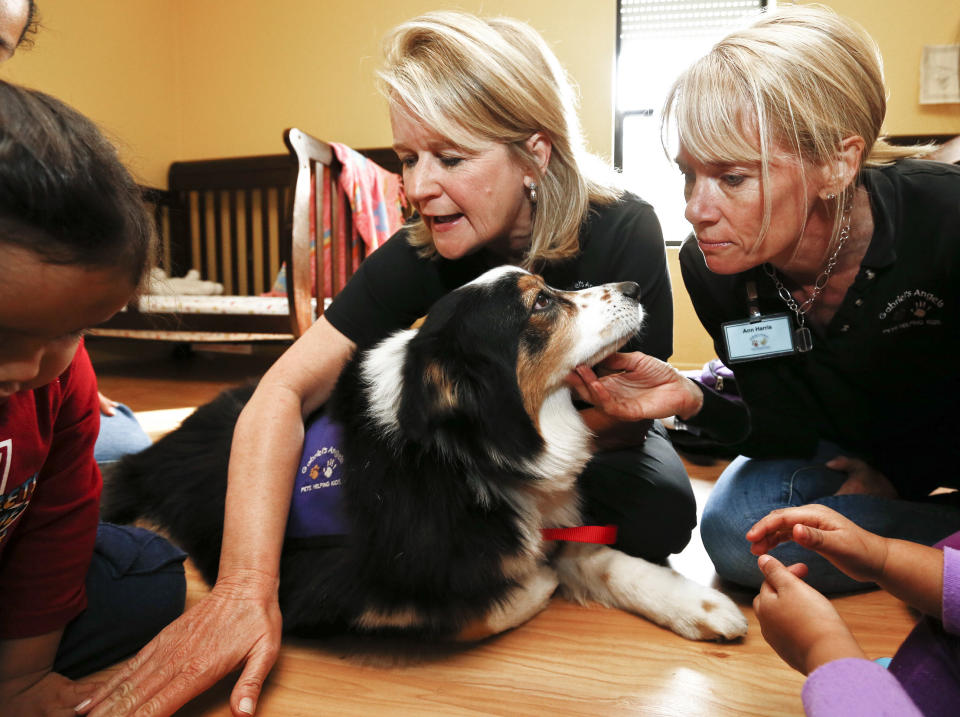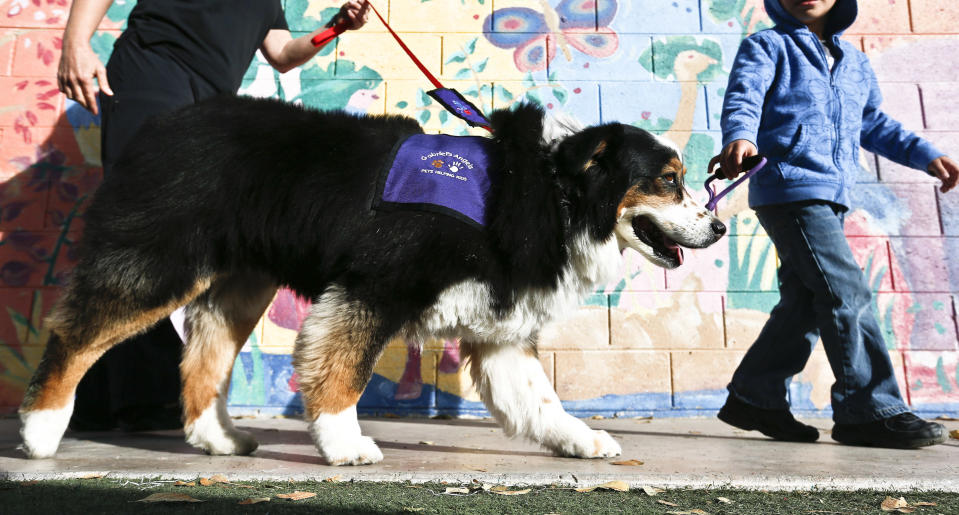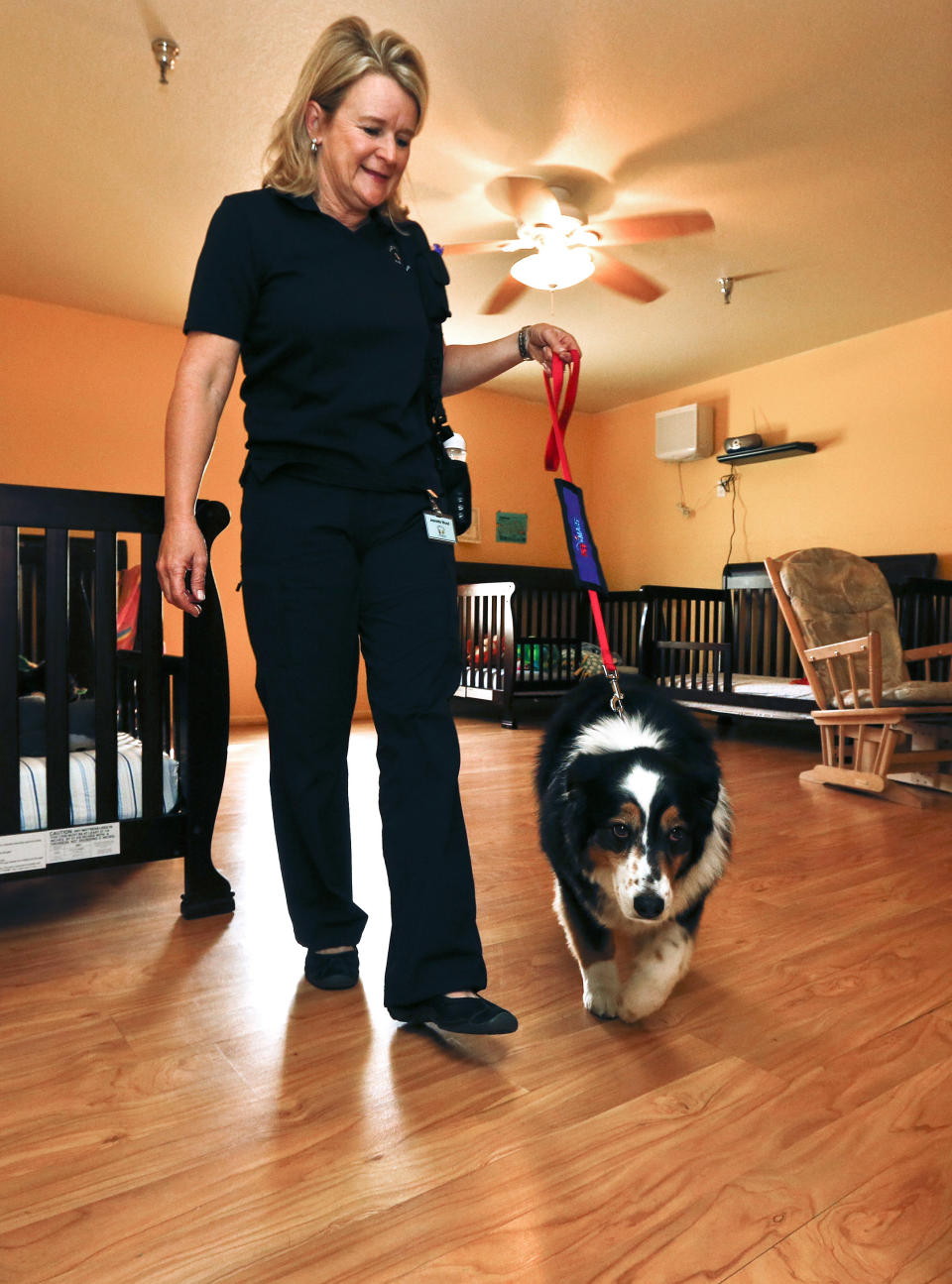Life as a therapy animal not for everyone
PHOENIX (AP) — The children buzz in excitement, boisterous and barging in, their little hands covering seemingly every part of the Australian shepherd's body.
Callie doesn't flinch, calmly lying at the center of this circle of chaos, lightly panting with what appears to be a smile.
Dogs don't really smile, but this one sure was at ease.
"She loves the attention," Callie's handler Jeanette Wood said during the visit to the Child Crisis Center in Phoenix. "She eats this stuff up."
Callie makes calm amid the clutter look easy, but it's not.
Being a therapy dog — or cat or horse or whatever — like Callie takes a special kind of animal, one with just the right temperament and personality. It also takes training, not just for the animal, but for the handler.
"You have to be a certain kind of person and have a certain kind of dog to do this," said Pam Gaber, founder of Gabriel's Angels, an Arizona-based nonprofit that delivers pet therapy to abused and at-risk children.
Therapy animals are used at hospitals, nursing homes, schools, rehabilitation centers, institutions and in one-on-one sessions with therapists. They also have been brought in to comfort victims of mass-casualty events, including the Newtown, Conn., school shooting and the Tucson shooting that targeted former U.S. Rep. Gabrielle Giffords.
They come from a wide range of species, from cats and rabbits to barnyard varieties like horses, goats and pigs. Exotic birds, hamsters and Guinea pigs, even llamas and alpacas also have been used to comfort people of all ages.
The most popular and recognizable therapy animals, not surprisingly, are dogs. And it's not even close.
Pet Partners, a nonprofit organization that promotes positive animal interactions as a therapeutic resource, has 11,000 therapy teams in 14 countries and 95 percent of their animals are dogs.
"Dogs are social by nature, but they're also accustomed to going with us, going out and meeting people," Bill Kueser, vice president of marketing for Pet Partners, based in Bellevue, Wash. "We take them on walks, we go with them to the pet store to get dog food. We integrate them in our lives in sort of a wider spectrum of activities than other pets and species are integrated."
A wide variety of breeds is used. Gabriel's Angels, which serves 13,000 children in Phoenix and Tucson, has everything from a 4-pound Chihuahua to a 190-pound English mastiff, though most of its animals are golden retrievers, labs or a mix with either breed.
But not every dog is suitable for therapy.
The key is temperament. Therapy dogs need to be relatively even-keeled and enjoy being around people.
If a dog cowers around new people, is too timid or overbearing, or gets jumpy when there's a lot of commotion, it probably won't be a good fit as a therapy dog.
"Sometimes the person wants it more than the dog," said Gaber, who started Gabriel's Angels after taking her Weimaraner, Gabriel, to the Crisis Nursery in Phoenix in 2000. "If they're in the corner cowering, let them stay home and sleep on your bed during the day if that's what they want."
The dogs also must have basic obedience skills so they're not jumping on people or pulling on the leash, and they must be able to follow commands without being distracted.
Most dogs in this line of work go through training, and are registered with organizations such as Pet Partners or Therapy Dogs Inc.
Pet Partners has its animals and trainers go through an eight-hour, in-person training program, or through an online course that typically takes six to eight hours to complete. Handlers learn how to read their animal's stress level and make the animal comfortable in a variety of environments.
Pet Partners teaches handlers about the types of people they might visit — whether it's seniors at a nursing home or troubled teens at a group home — and the kinds of procedures they might encounter, such as infection control at a hospital. They learn to work in conditions that they are likely to run into, such as being near wheelchairs or hearing loud, startling noises.
"You need to expose the animal to situations he or she might face when visiting a hospital or some other place," Kueser said. "Distractions, noises, crowded petting, erratic behavior are things we model in the (trainer) evaluation to make sure these things aren't overstressing to the animal."
Therapy animals are usually reevaluated every two years.
Gabriel's Angels has an extra step in its registration process, doing background checks, fingerprinting and asking for signed affidavits from handlers who will be interacting with children.
To get Callie ready for her foray into therapy for kids, Wood took her to playgrounds and had kids feed her treats; walked her through Home Depot and PetSmart; took her on buses and trains — any busy place she could find.
"The most important thing is to desensitize them so they'll be comfortable in these environments," she said.
With kids practically climbing on her, running brushes all over her coat and occasionally gripping her fur, there's not much doubt Callie is made for this.






